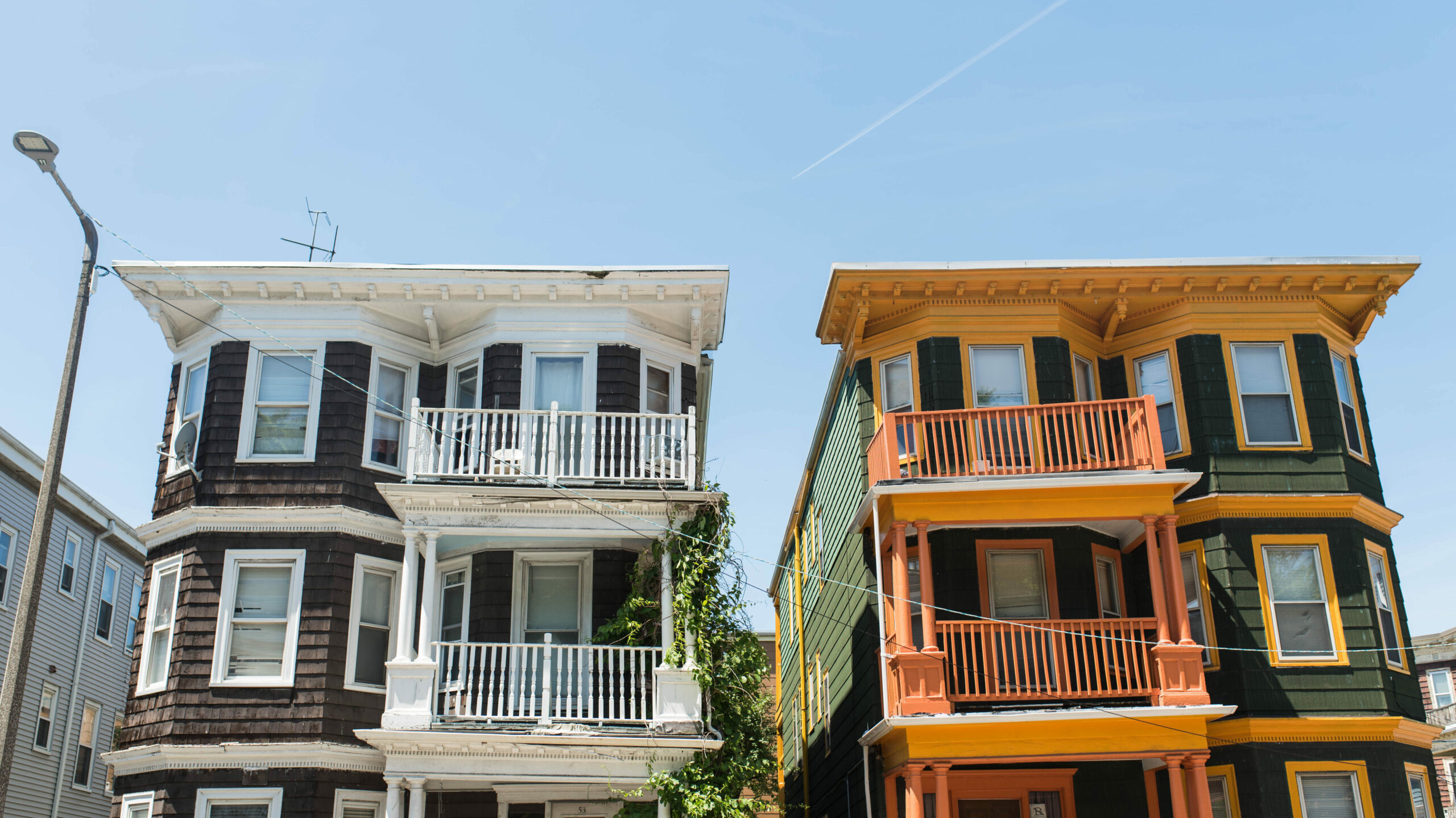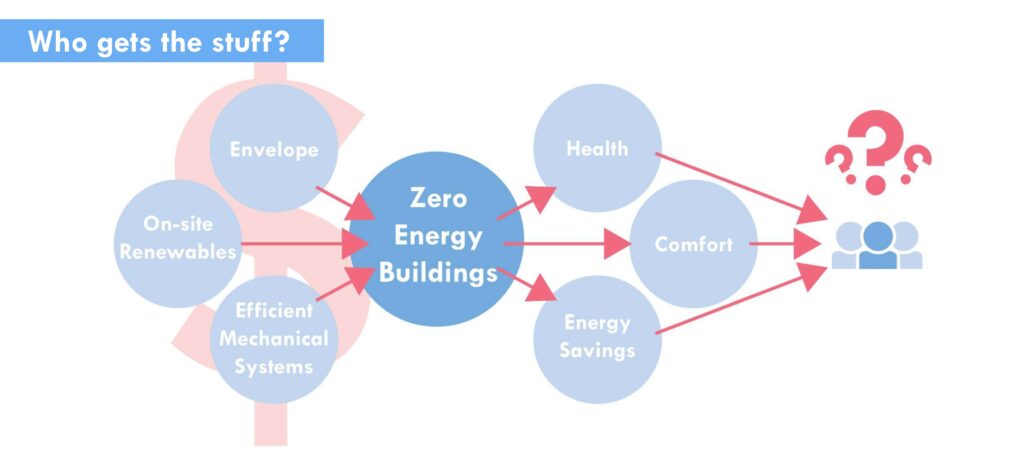BERDO & An Equitable Boston
Every building presents sustainable design opportunities. Even if a project will not pursue any certification, it is imperative to include sustainability into the design process and material and systems selections. DREAM’s goal is to always create healthy, energy-efficient places that provide comfort and support the environment. As an industry, we must enhance equity and accessibility to these spaces so that all people, communities, and neighborhoods can benefit from sustainability-focused public initiatives.

In 2016, the Brookings Institute found Boston to have the highest income inequality of any city in the country¹. A year later, Mayor Marty Walsh announced Carbon Free Boston², a sweeping plan to bring the city to zero emissions by 2050. While it may not be easy to see a clear line drawn between the two, our current policy makes some effort toward climate equity, but still ends up leaving folks behind. At DREAM, we strive to create equity and the greater good in our communities and hope that this challenge of pairing climate and equity is one that our city’s policymakers, stakeholders, and creatives tackle together.
The Carbon Free Boston plan covers sectors from utilities to transportation. As architects, we are concerned with our direct role in the emissions of the built environment, who has the opportunities to construct our built environment, and how our built environment impacts the lived experience of citizens. The 2019 Carbon Free Boston report³ found that 85% of the buildings we will need in 2050 are already built, which means that vast amounts of existing building stock need to be retrofitted for energy efficiency. The passage of the Building Energy Reporting and Disclosure Ordinance (BERDO) in 2014 gave us our first steps toward these goals, and the passage of BERDO 2.0 in 2021⁴ goes even further. The mandate from BERDO is that owners of all Boston buildings over 20,000 square feet or 15 residential units report their energy usage and make clear progress toward retrofitting their buildings to be net zero emissions by 2050.
These retrofits come in the form of energy-efficient building envelope refurbishment, replacement of dated mechanical and hot-water systems with more energy-efficient versions, and addition of on-site renewables to provide some—or even all—of a building’s power needs.
Make no mistake: BERDO is a monumental step toward reaching net zero emissions. However, over 25% of our city’s emissions come from small multifamily and single-family homes. Those triple-decker homes that are our city’s most prevalent housing typology are not included in BERDO. This broad swath of our housing stock is left out of the reporting requirements, but more crucially it is left out of the requirement to perform energy-efficient retrofits. The sustainability gains from retrofits. The sustainability gains from retrofits directly affect energy consumption and cost, which impact consumers in their utility payments.

With 64% of the city’s residents renting, and half of those experiencing rent burden⁵—defined as spending over a third of their income toward rent—a savings in utility bills can make a huge difference. Many of our city’s low-income renters occupy buildings that have long outdated systems and building envelopes. This means that not only are these renters more likely to be rent-burdened, they are more likely to be energy burdened as well—defined as pending over 6% of their income on utilities. A study by the American Council for an Energy-Efficient Economy (ACEEE) found that 24% of Boston residents experience energy burden, and a quarter of low-income households experience a burden above an astonishing 19% of their income⁶. Furthermore, structural racism over centuries has led to Black and Hispanic households experiencing an energy burden at a higher rate than the rest of the City: 32% and 30% respectively. Low-income residents have long been paying beyond their means just to have a shelter over their heads and stay warm through the winter.

To focus on the regulation: BERDO requires multifamily buildings to reach an emissions standard of 4.1 kg of carbon dioxide emitted per square foot each year (kgCO²e/SF/yr) by 2030. This standard is 55% lower than the baseline multifamily building in the region⁷. A good chunk of this efficiency gain can be achieved through shifting energy production to renewables. However, residents still have to pay for renewable energy and its transmission to our homes. So if we assume that residents of the triple-deckers across the City go without any retrofits, they miss out on potentially 55% savings to their utility bill. This could be the difference between making or missing a payment, and putting food on the table for low-income households.
For example, let’s examine a low-income renter in a triple-decker in Boston. Using the 200% Federal Poverty Limit referenced by ACEEE, we’ll start with a $55,000 income for a household of four⁸. Let’s assume the energy burden by this household is 10%, a figure well within—and perhaps below—a realistic range. That gives us $5,500 spent each year toward heating, cooling, and electrical bills. If this household’s triple-decker is renovated to meeting the 2030 BERDO goals, the household would save $3,025 each year. Instead, under the current BERDO regulations this building typology is omitted, resulting in thousands of Boston residents not participating in savings, as wealthier residents in larger buildings see their energy bills reduced—thus exacerbating wealth inequity.

If the City of Boston wants to bring energy benefits to every resident, a few things need to happen. First, BERDO needs to expand to include every building type. The administration of such a reporting system is a large task, but one worth putting resources behind. A carbon-neutral city requires everyone and every building pulling together. Second, the City of Boston and the utilities servicing the City need to service a fund that has the explicit goal of retrofitting triple-deckers and other small buildings. Through BERDO 2.0 includes language towards creating an Equitable Emissions Investment Fund, the ordinance does not provide discrete, measurable, or actionable goals. Third, any fund created by the City should provide outreach to small building owners, best practices for retrofits, and training for minority contractors to do the work. The recent “Future-Decker Design Challenge” competition hosted by the MassCEC⁹ provides bold, creative, and practical solutions to modernize our housing stock that should be commended and implemented.
If the City of Boston does not implement a citywide BERDO that includes triple-deckers, one of the city’s most recognizable building typologies, and the funding to help low-income building owners to perform retrofits, it is further widening inequity as a result of continued energy burden as wealthier residents enjoy the financial benefits of higher efficiency homes. Our mission toward social equity and the greater good gives DREAM Collaborative a unique perspective on these unintended consequences. We encourage our community to join us in rising to the challenge of creating a just future for all.




This piece is contributed by DREAM Collaborative’s Rand Lemley AIA, CPHC. Rand has been with DREAM since 2018 and operates with an acute sense of responsibility to push for the greater good. He is adept in cross-disciplinary collaborations that aim at leveraging each team member’s expertise to create beautiful, equitable, sustainable futures.
Rand is a register architect and a Certified Passive House Consultant. He received his Masters of Real Estate and Development and Bachelor of Architecture from the Boston Architectural College and his Associates of General Studies from Central Texas College.
¹ https://www.brookings.edu/research/city-and-metropolitan-inequality-on-the-rise-driven-by-declining-incomes/
² https://www.greenribboncommission.org/work/carbon-free-boston/
³ Carbon Free Boston, Summary Report 2019 https://www.greenribboncommission.org/document/executive-summary-carbon-free-boston/
⁴ ORDINANCE AMENDING CITY OF BOSTON CODE, ORDINANCES, CHAPTER VII, SECTIONS 7-2.1 AND 7-2.2, BUILDING ENERGY REPORTING AND DISCLOSURE (BERDO), https://d279m997dpfwgl.cloudfront.net/wp/2021/06/berdo.pdf
⁵ Scott Bailey, “How to make Rent Affordable in Boston”, Boston Globe, May 3, 2021.
⁶ American Council for an Energy-Efficient Economy, Energy Burden in Boston, September 2020. https://www.aceee.org/sites/default/files/pdfs/aceee-01_energy_burden_-_boston.pdf
⁷ The baseline multifamily building emits approximately 7.2 kgCO2e/SF/yr according to Zero Tool, the platform developed by Architecture 2030 to track and encourage lower emissions in the building industry.
⁸ $55,000 for a household of four is below the 50% area median income (AMI) for Boston as defined by Boston Planning and Development Authority in their inclusionary development policy.
⁹ https://www.masscec.com/triple-decker-design-challenge